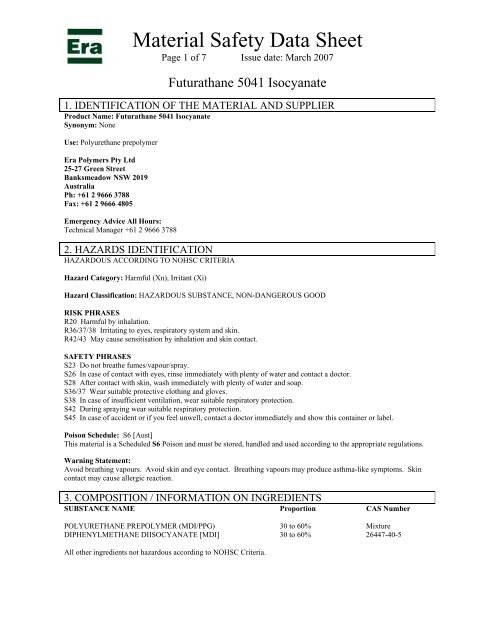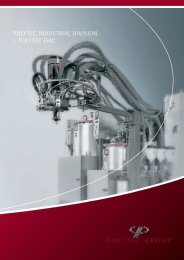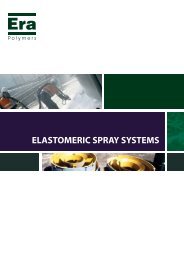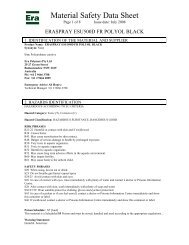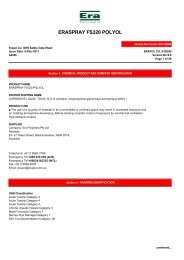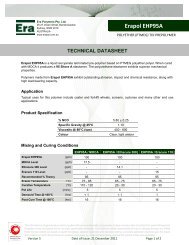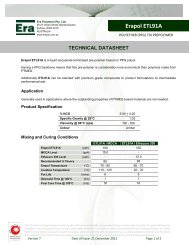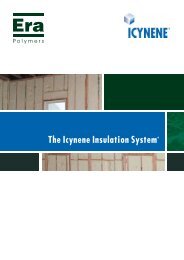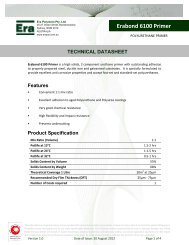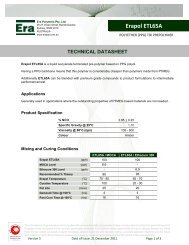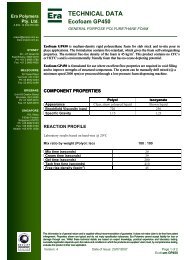Material Safety Data Sheet - Era Polymers
Material Safety Data Sheet - Era Polymers
Material Safety Data Sheet - Era Polymers
You also want an ePaper? Increase the reach of your titles
YUMPU automatically turns print PDFs into web optimized ePapers that Google loves.
<strong>Material</strong> <strong>Safety</strong> <strong>Data</strong> <strong>Sheet</strong>Page 3 of 7 Issue date: March 2007Futurathane 5041 Isocyanatethe leak, where possible. Ventilate area. Contain the spill to prevent further spread of material and prevent run off intodrains and waterways. Use absorbent material such as wet sand, wet earth, wet sawdust or absorbent clays. Thesematerials will not only contain the spill, but also absorb and partially neutralise the diisocyanate content of the material.Neutralise used absorbent materials and any remaining product with neutraliser (see below) and decontaminate allsurfaces and equipment that have been in contact. Dispose of all clean-up materials in accordance with governmentregulations.Neutraliser formulations include:(a) surfactant 1 - 20% and water to make up to 100%;(b) liquid surfactant 0.2 - 2%, sodium carbonate 5 - 10%, and water to make up to 100%;(c) liquid surfactant 0.2 - 2%, concentrated ammonia 3 - 8% and water to make up to 100%.7. HANDLING AND STORAGEWater, either as liquid or as vapour, must be rigorously excluded from the material during both handling and storage, asthe product will react with water giving insoluble polyurea and liberating carbon dioxide gas. In a closed container, thiscould cause the container to rupture.Store in a cool place and out of direct sunlight. Store away from sources of heat or ignition. Store away from strongoxidizing agents. Keep containers tightly closed, when not using the product. Store in original packages as approvedby manufacturer. Purge with nitrogen and close container when not in use. Do not eat, drink or smoke in theworkplace.Refer to manufacturer for correct usage instructions for this product. This product should only be used as intended bythe manufacturer.8. EXPOSURE CONTROLS / PERSONAL PROTECTIONExposure StandardsNo exposure standards are available for this product, however, the following exposure standards have been assigned by[NOHSC] to the following components of the product:***************************POLYURETHANE PREPOLYMER (MDI/PPG)No Exposure details availableDIPHENYLMETHANE DIISOCYANATE [MDI](NOHSC Australia)Isocyanates, all (as -NCO)[TWA] 0.02 mg/m³[STEL] 0.07 mg/m³Notices: SenEngineering ControlsMaintain adequate general and local exhaust ventilation at all times. In particular, respiratory protection should be usedwhen heating isocyanates. Ensure sufficient ventilation is available when spraying the product.Personal Protection EquipmentCLOTHING: Wear suitable protective clothing to prevent risk of skin contact.GLOVES: Wear impervious gloves to prevent risk of skin contact - PVC or natural rubber.EYES: Wear protective eyewear, such as safety glasses with side shields, chemical goggles or face shield to protecteyes.RESPIRATORY PROTECTION: Avoid breathing of vapours/spray. If exhaust ventilation is not available orinadequate, use approved respirator to Australian Standards. Respiratory protection must be worn when spraying theproduct. Select and use respirators in accordance with AS/NZS 1715/1716. The use of a respirator for organic vapourswith (disposable) or with replaceable filters is recommended. Filter capacity and respirator type depends on exposurelevels and type of contaminant. If entering spaces where the airborne concentration of a contaminant is unknown thenthe use of a Self-contained breathing apparatus (SCBA) with positive pressure air supply complying with AS/NZS 1715/ 1716, or any other acceptable International Standard is recommended.
<strong>Material</strong> <strong>Safety</strong> <strong>Data</strong> <strong>Sheet</strong>Page 4 of 7 Issue date: March 2007Futurathane 5041 Isocyanate9. PHYSICAL AND CHEMICAL PROPERTIESAppearance:Clear pale yellow liquidBoiling Point Melting Point: BP > 250°CVapour Pressure:Not determinedSpecific Gravity: 1.1 @ 25°CFlash Point: > 150°C (Cleveland cup ASTM D92)Flammability Limits:Not applicableSolubility in Water:Reacts with water liberating carbon dioxideOther PropertiesNone determined.10. STABILITY AND REACTIVITYSTABILITY:Stable under normal conditions of use.HAZARDOUS DECOMPOSITION PRODUCTS:Emits toxic fumes including oxides of carbon and nitrogen, hydrogen cyanide and isocyanate vapours when heated todecomposition.HAZARDOUS POLYMERIZATION:Will not occur under normal conditions of use.INCOMPATIBILITIES:Strong alkalis, strong acids, strong oxidizing agents, alcohols, amines, carboxylic acids and water.CONDITIONS TO AVOID:Heat, flames, ignition sources, moisture and incompatibles.11. TOXICOLOGICAL INFORMATIONNo adverse health effects are expected, if the product is handled in accordance with this <strong>Material</strong> <strong>Safety</strong> <strong>Data</strong> <strong>Sheet</strong> andthe product label. Symptoms and effects that may arise if the product is mishandled and overexposure occurs are:ACUTE HEALTH EFFECTS:Swallowed:May cause irritation to mouth, throat and stomach with effects including mucous build up, irritation to the tongue andlips and pains in the stomach, which may lead to nausea, vomiting and diarrhoea.Eye:Will cause irritation to the eyes, with effects including: tearing, pain, stinging and blurred vision. Depending uponduration of exposure, eye damage may occur.Skin:Will cause irritation to the skin, with effects including: redness, itchiness, and possible dermatitis.Inhaled:Harmful if inhaled.The effects may be immediate or delayed. Mild cases: there may be a slight irritation of the nose and throat, there maybe dryness of the throat, wheezing, tightness of the chest, coughing or shortness of breath. Severe cases: the victim maysuffer acute bronchial irritation with difficulty in breathing, or even bronchospasm.Chronic:Prolonged or repeated contact with this substance will cause sensitisation by inhalation. Overexposure todiphenylmethane diisocyanate can lead to adverse respiratory effects, which may include the development of asthma.Once asthma has developed and a person has become sensitised to a diisocyanate, even concentrations well below thepermitted exposure levels can be sufficient to induce an asthmatic attack.
<strong>Material</strong> <strong>Safety</strong> <strong>Data</strong> <strong>Sheet</strong>Page 5 of 7 Issue date: March 2007Futurathane 5041 IsocyanateProlonged or repeated skin contact may lead to dermatitis.Prolonged contact may cause severe eye irritation.Prolonged or repeated exposure may lead to irreversible damage to health.Prolonged or repeated contact with this substance will cause sensitisation by inhalation.Prolonged or repeated contact with this substance will cause sensitisation by skin contact.Toxicological <strong>Data</strong>:There is no other toxicological information available for this product.Toxicological <strong>Data</strong> for Ingredient(s):DIPHENYLMETHANE DIISOCYANATE [MDI]:Oral: LD50 (rat) > 5000 mg/kgDermal: LD50 (rabbit) > 2000 mg/kgInhalation: LC50 (4 hour, rat) = 490 mg/m3 (aerosol)Genetic toxicology: the assessment of all available data indicates that diphenylmethane diisocyanate has no significantmutagenic potential.Reproductive toxicology: there has been no observation of demonstration of adverse effects on reproduction due todiphenylmethane diisocyanate.12. ECOLOGICAL INFORMATIONEcotoxity:There is no information available for this product.Information for Ingredient(s):Diphenylmethane diisocyanate [MDI] generally shows low toxicity to a wide range of water and soil based species:bacteria, algae, invertebrates, fish, earthworms, plants and birds.Algae: EC50, 72 hour (Scenedesmus subspicatus, freshwater) = 1640 mg/LInvertebrates: EC50, 24 hour (Daphnia magna, freshwater) >= 500 mg/LFish: LC0, 96 hour (Brachydanio rerio, freshwater) >= 1000 mg/LMobility:The product is insoluble in water and does not disperse readily. It reacts with water forming polyurea, which is solid,insoluble and stable in the environment to both chemical and biological attack.Persistence / Degradability:This substance is not persistent in the environment as it reacts with water or moisture in the air. The reaction product,an inert, insoluble polyurea, is not readily degradable.Chemical Fate Information:There is limited ecological information available for this product, however, large quantities should not be dischargedinto drains, sewers or waterways.13. DISPOSAL CONSIDERATIONSDo not allow into any sewers, drains, on the ground or into any body of water. Any disposal must be in accordancewith applicable State, Territory and/or Local government regulations.Product Waste: The disposal of large quantities of product should normally be undertaken only by a specialistcontractor. The product may be incinerated in a suitable facility, however consult with local authorities before doing soto ensure that all local regulations are observed.In the case of only a small quantity of product waste, the following method may be applied, with caution, by atechnically competent person: The waste product is reacted with an excess of Polyol to form a foam or solidpolyurethane. The product of the reaction can then be incinerated or disposed of in landfill. This process should becarried out slowly in an open drum to avoid rapid heat generation and release of gases.Container Disposal: Any disposal of contaminated packaging and washings must be in accordance with State, Territoryand/or Local government regulations. When containers/drums have been drained to leave as little residue as possible,
<strong>Material</strong> <strong>Safety</strong> <strong>Data</strong> <strong>Sheet</strong>Page 6 of 7 Issue date: March 2007Futurathane 5041 Isocyanateeither seal the drum and send it to a drum-handling specialist, or decontaminate the drum using a slow reacting waterbasedneutraliser (see below). Add (several centimetres of) neutraliser to the drum, slowly shake and roll to allowcontact. Leave open until all reaction is completed, then dispose of drum and washings in approved manner. If thecontainer is to be reconditioned, the reconditioning company should be made aware of the nature of the originalcontents.Neutraliser formulations:(a) surfactant 1-20% and water to make up to 100%;(b) liquid detergent 2%, PEG400 35% and water to make up to 100%.14. TRANSPORT INFORMATIONRoad TransportUN Number: None allocatedProper Shipping Name: NONE ALLOCATEDDangerous Goods Class: None allocatedPacking Group: None allocatedLabel: Harmful (Xn), Irritant (Xi)Air TransportUN Number: None allocatedProper Shipping Name: NONE ALLOCATEDDangerous Goods Class: None allocatedPacking Group: None allocatedLabel: Harmful (Xn), Irritant (Xi)Sea TransportUN Number: None allocatedProper Shipping Name: NONE ALLOCATEDDangerous Goods Class: None allocatedPacking Group: None allocatedLabel: Harmful (Xn), Irritant (Xi)15. REGULATORY INFORMATIONPoison Schedule: S6 [Aust]Inventory Status:Inventory StatusAustralia (AICS)YY = all ingredients are on the inventory.16. OTHER INFORMATIONDate of Preparation:Issue date: 14/03/2007Supersedes: May 2006Reasons for Update:Product reformulated.Key Legend Information:NOHSC - National Occupational Health & <strong>Safety</strong> Commission {Formerly Worksafe}[Aust]SUSDP - Standard for the Uniform Scheduling of Drugs and Poisons [Aust]TWA - Time Weighted Average [Int]STEL - Short Term Exposure Limit [Int]AICS - Australian Inventory of Chemical SubstancesEPA - Environmental Protection Agency [Int]
<strong>Material</strong> <strong>Safety</strong> <strong>Data</strong> <strong>Sheet</strong>Page 7 of 7 Issue date: March 2007Futurathane 5041 IsocyanateNIOSH - National Institute for Occupational <strong>Safety</strong> and Health [US]AS/NZS 1715 - Selection, use and maintenance of respiratory protective devices. [Aust/NZ]AS/NZS 1716 - Respiratory protective devices. [Aust/NZ]IATA - International Aviation Transport Authority [Int]ICAO - International Civil Aviation Organization [Int]IMO - International Maritime Organisation. [Int]IMDG - International Maritime Dangerous Goods [Int]United Nations Recommendations for the Transport of Dangerous Goods and Globally Harmonized System for theclassification and labelling of Chemicals. [Int]EU - European Union[Aust/NZ] = Australian New Zealand[Int] = International[US] = United States of AmericaRemoval of the heading of Poison Schedule [Aust], in section 3 and 15 of this <strong>Material</strong> <strong>Safety</strong> <strong>Data</strong> <strong>Sheet</strong> (MSDS)makes this a valid health and safety document in other international jurisdictions/countries. For full compliance pleasecontact your Federal, State or Local regulators for further information.DisclaimerThis MSDS summarises our best knowledge of the health and safety hazard information available on the product andthe measures to be used to handle and use the product safely. Each user should read this MSDS and consider theinformation in connection with the way the product is intended to be handled or used.Principal References:Information supplied by manufacturer, reference sources including the public domain.END OF MSDS


